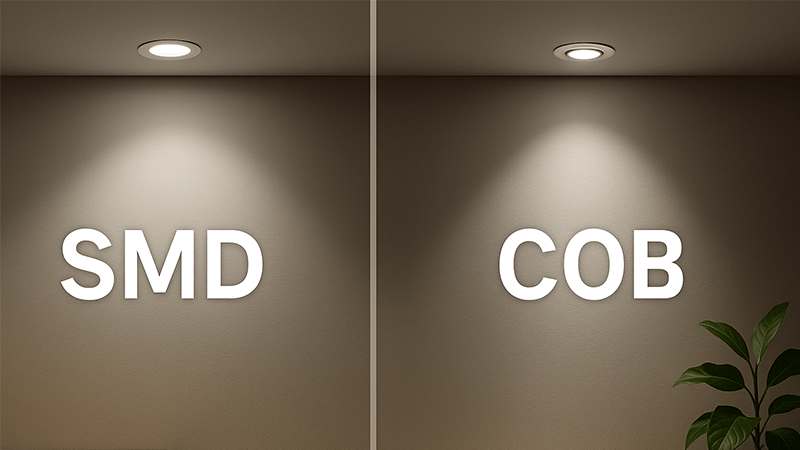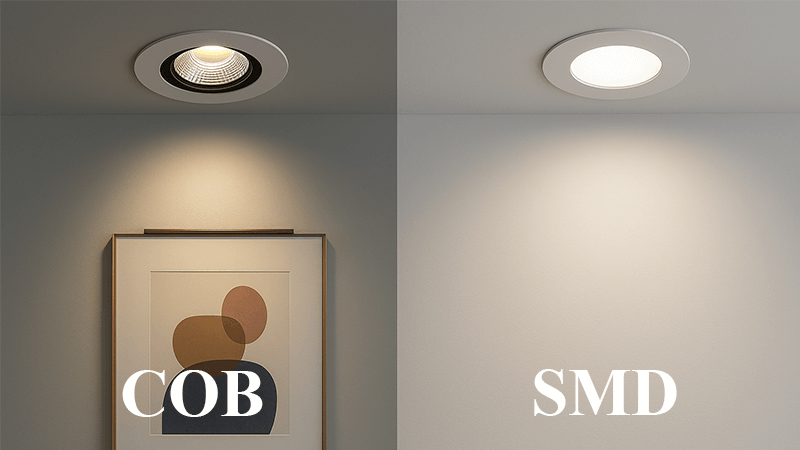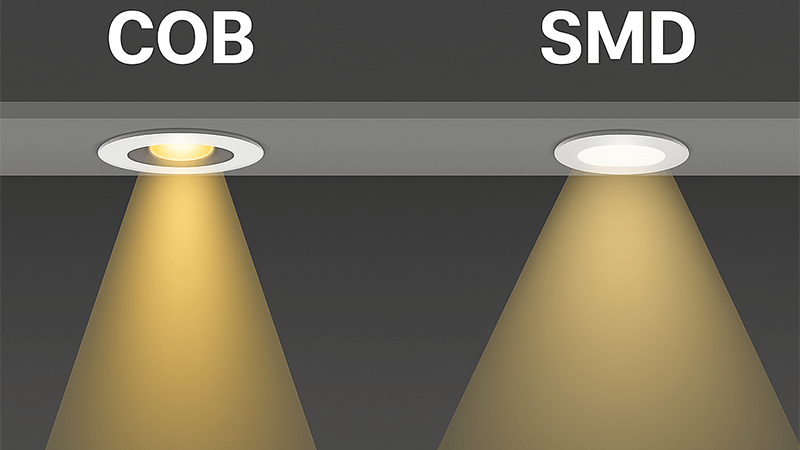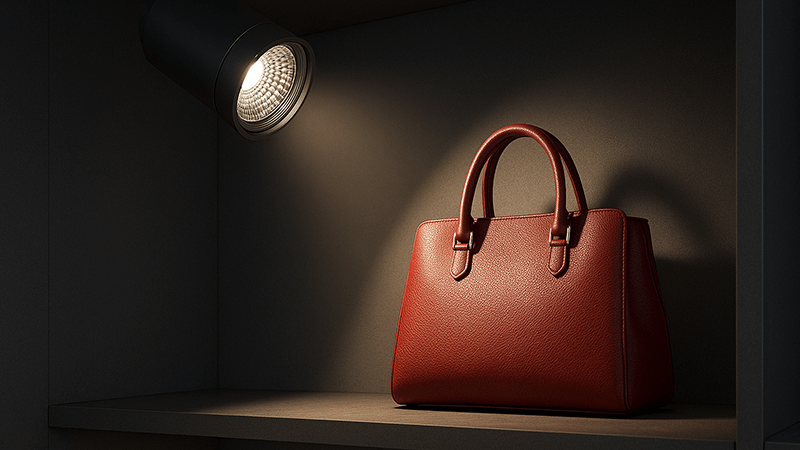Struggling to choose the right downlight? The technical jargon of SMD and COB can be confusing, leaving you worried about making the wrong, costly choice for your project.
The main difference is how the LED chips are packaged. SMD (Surface Mounted Device) uses multiple individual chips on a board, creating a wider, more scattered light. COB (Chip on Board) uses a single, large chip, producing a focused, uniform beam of light, similar to a traditional halogen.

Understanding this basic difference is a great start. But as a purchasing manager or project contractor, you need to know which one is truly better for your specific needs. Let’s break down the details so you can make an informed decision and confidently source the best products for your clients.
Which is better, COB or SMD LED?
Feeling uncertain about which LED technology to back? Choosing the wrong one can lead to unhappy clients and subpar lighting performance. Let’s find the clear winner for your specific application.
Neither is universally "better," as it depends on the application. For focused, high-quality accent lighting like in retail or galleries, COB is superior. For general, wide-area illumination like in offices or warehouses, the broader beam of SMD is often more practical and cost-effective.

The question of "better" really comes down to what you want to achieve with your lighting. In my years of manufacturing, I’ve seen both technologies used effectively. The key is to match the technology to the job. Think of it like choosing between a floodlight and a spotlight; one isn’t better than the other, they just have different purposes.
To help you decide, let’s compare them side-by-side on the factors that matter most to professionals like you.
| Feature |
COB (Chip on Board) |
SMD (Surface Mounted Device) |
| Light Appearance |
Single, uniform light source |
Multiple points of light |
| Beam Quality |
Clean, focused beam; no ghosting |
Wider, more diffuse beam |
| Best Application |
Accent, track, and high-end downlights |
General area and panel lights |
| Heat Management |
More efficient, better dissipation |
Can be less efficient per unit area |
| Lumen Density |
Higher (more light from a small area) |
Lower |
| Cost |
Generally higher |
More economical for wide coverage |
For a client like Shaz in the UAE, who handles large-scale projects, this choice is critical. If he’s outfitting a luxury hotel lobby, the clean, high-end look of COB downlights is the only way to go. The single light source avoids the multiple shadows and "dotty" look that can come from SMD chips. However, for a large office space requiring even, widespread light, SMD-based panel lights are often the more economical and practical solution. The choice isn’t just technical, it directly impacts the project’s budget and the final aesthetic result.
Are COB lights better for downlights?
Choosing a downlight seems simple, but the wrong choice creates harsh, uneven light. You worry about specifying a product that looks cheap and performs poorly, reflecting badly on your project.
Yes, for most modern downlight applications, COB lights are better. They produce a superior quality of light with a clean, uniform beam and no secondary glare or "ghost" spots. This makes them the go-to choice for creating a professional and high-end lighting environment.

In my experience, the lighting industry has clearly shifted towards COB for quality downlights. When I started my factory, SMD was the dominant technology. But as customers became more sophisticated, the demand for better light quality grew. This is where COB technology really shines, quite literally.
The main reason is the visual comfort and quality. Let me break down exactly why COB is the preferred choice for downlights in residential and commercial spaces.
The Problem with Multi-Shadows
SMD downlights use an array of individual LED chips. Even with a good diffuser, each chip acts as a tiny light source. When this light hits an object, it can create multiple, faint shadows. This effect, sometimes called ghosting, can be distracting and makes a space feel cluttered and visually "noisy." For a retail display or a piece of art, this can ruin the presentation.
The COB Solution: A Single, Clean Beam
COB technology solves this completely. By packing all the LED chips into one single module, it acts as a single point of light. The result is a clean, sharp, single shadow, just like you would get from a traditional halogen bulb. This is why lighting designers and architects almost exclusively specify COB for applications where quality matters. I often tell my clients, if you want to test the quality of a downlight, just hold your hand under it. If you see one clean shadow, you have a good COB light. If you see a fuzzy edge or multiple shadows, it’s likely an older SMD model. This simple test never fails.
Which is better, a standard downlight or a COB light?
You need to source downlights, but the options are overwhelming. A "standard" downlight is often cheaper, but you’re concerned it won’t deliver the performance your high-end project requires.
A COB light is a type of downlight, and it is the better option for quality. A "standard" downlight often refers to an older, cheaper SMD model. Choosing COB ensures superior beam control, higher visual comfort, and the premium look expected in modern projects.

This question often comes up, and it’s based on a slight confusion. "COB light" describes the engine inside the fixture, while "downlight" is the fixture type itself. Most high-quality downlights sold today are, in fact, COB downlights. The term "standard downlight" has become shorthand for the older, less expensive SMD models that used to be common.
So, the real question is: why should you pay more for a COB downlight over a basic SMD model? The answer lies in performance and value, not just initial cost.
Deeper Dive into Light Control
A downlight’s job is to direct light downwards effectively. COB technology is perfect for this. Because it’s a small, intense light source, it works beautifully with reflectors and lenses. This allows us to design fixtures with very precise beam angles. Do you need a narrow 15-degree spot to highlight a small object? Or a wider 60-degree beam for general lighting in a room? With COB, we can engineer the optics to control the light exactly where you want it. SMD lights, with their wide, scattered array of chips, are much harder to control with this level of precision. The light spills everywhere, creating glare and wasting energy.
The Importance of Glare Control (UGR)
In commercial and office lighting, the Unified Glare Rating (UGR) is a critical metric. A low UGR means less eye strain and more comfort for the people in the space. COB downlights, especially when set deeper into the fixture (a design we call anti-glare), are excellent at achieving a low UGR. The small source can be easily shielded from direct view. This is something I work on constantly with my design team. For a purchasing manager like Shaz, specifying a downlight with UGR<19 is often a requirement for office projects, and COB is the most reliable way to meet that spec.
Are COB spotlights a better choice?
Your project requires spotlights, but you’re not sure which technology to trust. Choosing the wrong one can result in weak accents, poor color, and a cheap look that undermines the whole design.
Absolutely. For spotlights, COB technology is almost always the better choice. Its ability to create a strong, focused, high-intensity beam from a compact source is exactly what a spotlight is designed to do. It delivers the punch and drama that SMD lights simply cannot match.

When it comes to spotlights, there is very little debate in the industry: COB is king. A spotlight’s entire purpose is to draw attention, to create contrast, and to highlight features. This requires a punchy, focused beam of light, and that is COB’s greatest strength.
I remember working with a retail client who was using old SMD track lights. Their merchandise looked flat and unappealing. We replaced them with COB spotlights with a high Color Rendering Index (CRI). The difference was immediate and dramatic. The colors on the clothing popped, the textures were visible, and the entire display felt more premium and inviting. Sales in that section increased by nearly 20% in the following month. That is the power of good spotlighting, and that power comes from COB technology.
The Center Beam Candle Power (CBCP) Advantage
For spotlights, one of the most important metrics is Center Beam Candle Power (CBCP). This measures the intensity of the light at the very center of the beam. A high CBCP means a powerful, "punchy" beam that can highlight an object even from a distance or in a brightly lit room. COB lights naturally excel here. Their compact, high-density chip creates an incredible amount of light from a small point, resulting in a very high CBCP. SMD lights, being spread out, have a much lower CBCP and produce a "softer" beam that is unsuitable for dramatic accent lighting.
The Mainstream Choice for a Reason
Today, if you’re sourcing spotlights or track lights for any mid-to-high-end commercial, retail, or hospitality project, they will be using COB technology. It has become the undisputed standard for performance. In fact, one of the easiest tips I give my clients is this: when you go to buy, just tell the supplier, "I want a uniform light spot with no secondary spots or fuzzy edges." A knowledgeable seller will immediately know you’re asking for a quality COB product. It’s a simple way to cut through the jargon and get straight to the quality you need.
Conclusion
Ultimately, COB technology is superior for quality downlights and spotlights, offering a clean, focused beam. SMD remains a practical, cost-effective choice for wide, general-area illumination.